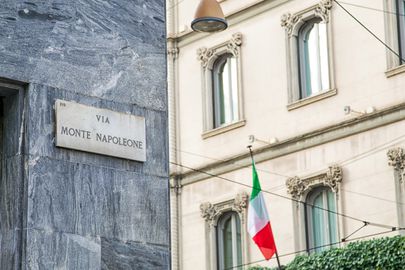

There are two landmarks in Milan that attract people from all walks of life: the Duomo and Via Montenapoleone. Everyone, regardless of whether he or she is religious, will visit the Duomo and everyone, regardless of whether he or she follows fashion, will walk down Via Montenapoleone. To see the other landmarks and attractions in the city one has to have a particular interest - art lovers will head for the Brera Museum, opera fanatics will visit La Scala, history buffs will check out Castello Sforzesco. But the Duomo and Via Montenapoleone appeal to everyone, even if the tourist is not interested in the subject matter. This reasoning is beyond logic. It is just something the tourist has to do: visit the Duomo and walk down Via Montenapoleone, whether he wants to or not - it is just programmed in his subconsciousness.
The comparison to the Duomo is not accidental, however. Via Montenapoleone is indeed sacred to fashion lovers, who make pilgrimages to the street once a year on Fashion Week in February. However, you do not need to wait until February to buy something or simply try it on or just goggle at the window displays.
Via Montenapoleone takes its name from two separate elements: an early 18th century financial institution by the name of Monte Camerale di Santa Teresa, after which the street was first named, and Napoleon Bonaparte who established the Cisalpine Republic in 1797, making Milan its capital. In the 19th century the street underwent thorough reconstruction that gave it an elegant neo-classical look. In 1840 composer Giuseppe Verdi stayed in Via Montenapoleone composing his opera Nabucco. In 1848 during the Five Days of Milan, when the Milanese rebelled against Austrian Occupation, the headquarters that coordinated the uprising was located on the street. Towards the end of the 19th century it became more and more luxurious, with the cream of Milanese society purchasing real estate throughout the street and opening shops selling rare antiques and priceless jewelry. In fact, Montenapoleone jeweler Annibale Cusi became the official jeweler of the royal family after Italy's unification. Unfortunately, many notable buildings did not survive the WWII bombing. One of them was the street's most distinguished palace - the 15th century Palazzo Marliani on the corner of Via Sant'Andrea, which had housed the Monte Camerale financial institution.
It was actually after the war that Via Montenapoleone gained its fame as one of the foremost thoroughfares in international fashion. By the end of the 20th century, thanks to the boom of Italian haute couture and Milan's triumph as fashion capital of the world, the street had surpassed in reputation and flair London's Bond Street and Paris' Rue du Faubourg-Saint-Honore.
Today Via Montenapoleone is lined by shops and salons representing the greatest names in Italian fashion: La Perla, Fratelli Rossetti, Versace, Armani, Ferragamo, Gucci, Prada, Valentino, Bulgari and others. It is without doubt the most famous single street in Milan, and perhaps in all of Italy.